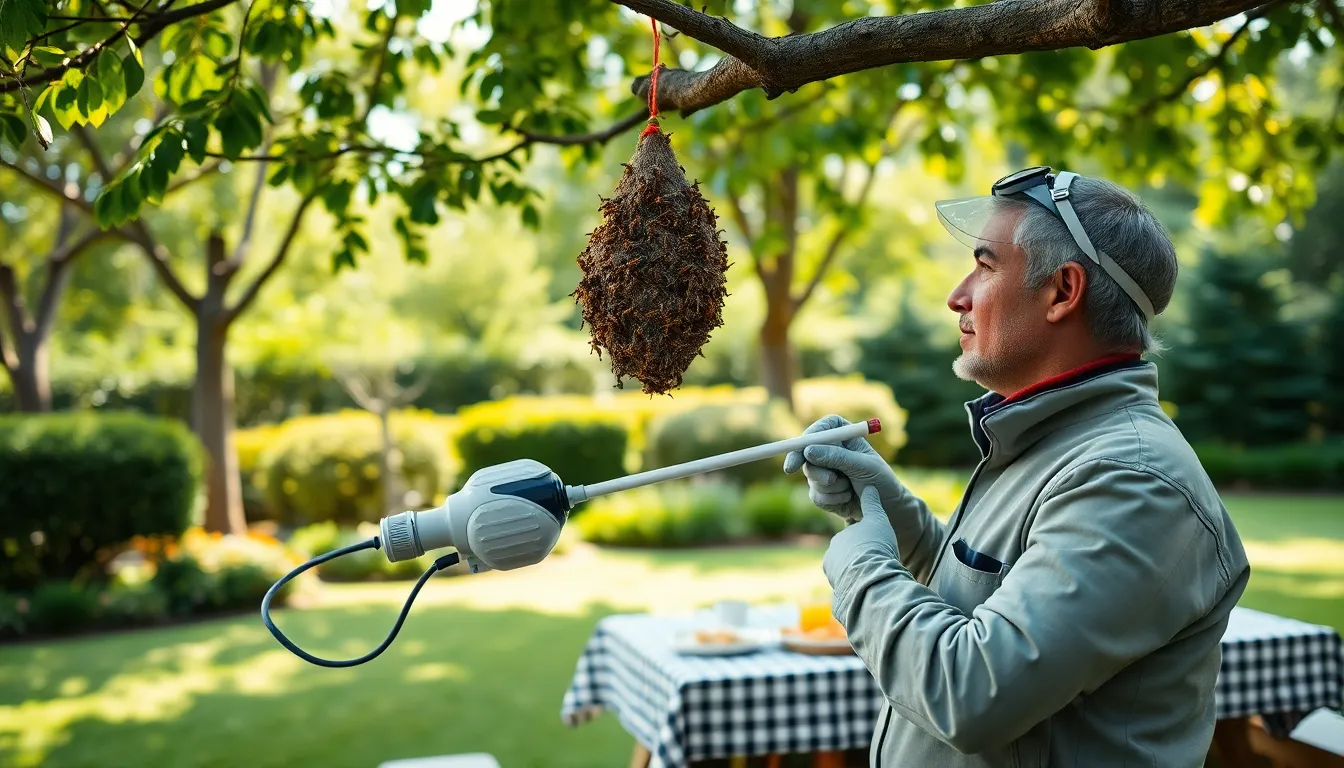Table of Contents
ToggleIf you’ve ever been buzzed at while trying to enjoy an outdoor barbecue, you know just how annoying wasps can be. Not to mention, they’re like that uninvited guest who refuses to leave. Fear not, because understanding these buzzing threats and learning how to keep them off your property doesn’t have to be as daunting as navigating a maze. In this guide, we’ll jump into the world of wasps, exploring their behavior, how to identify them, and what you can do to maintain a peaceful coexistence, or, when all else fails, send them packing.
Understanding Wasps: Behavior and Biology

Wasps belong to the order Hymenoptera, which they share with bees and ants. These creatures play vital roles in our ecosystem, such as pollination and pest control. But, their behavior can invoke both fear and frustration. Heavily relying on social structures, some species, such as yellow jackets and paper wasps, live in colonies that can number in the hundreds or thousands.
Understanding their biology helps in grasping how to control them effectively. Wasps have slender bodies, usually adorned with a pair of wings and distinct color patterns. A notable feature of their biology is their nest-building capabilities. Made from a paper-like substance created by chewing wood fibers mixed with saliva, their nests can be hugely prolific. Not just an eyesore, a wasp nest can lead to painful stings when disturbed. Surprisingly, wasps are generally less aggressive than bees unless they feel threatened, partially explaining why they can cause havoc during outdoor gatherings.
Knowledge of wasp biology aids in identifying behaviors. For instance, wasps hunt for food, often scavenging around outdoor picnics or food scraps, making it crucial to keep spaces clean to deter them.
Common Types of Wasps That Cause Problems
When it comes to pest control, knowing your enemy is half the battle. Some wasps stand out as more problematic than others. The yellow jacket, notorious for its aggressive nature, is a common nuisance during late summer and fall. Found in both urban and rural settings, these wasps will scavenge for sweet foods, making them unwelcome companions at picnics.
Another troublesome type is the paper wasp. Their nests, often hanging from eaves or branches, resemble open umbrellas. Though they can be more docile than yellow jackets, they’ll defend their homes ferociously if threatened. Then we have the hornets, which, even though a scary-sounding name, are simply a larger species of wasps. The bald-faced hornet, in particular, is known for building large, football-shaped nests, causing both dread and discomfort to anyone who stumbles upon it.
Identifying the type of wasp you are dealing with helps in determining the best approach to control them effectively.
Identifying Wasp Nests and Infestations
Identifying wasp nests requires keen observation and a bit of patience. Nests are typically located in sheltered areas, such as under eaves, inside attics, or hidden among tall grasses. Spotting activity is crucial, look for wasps darting in and out of potential nesting sites.
Once a nest is established, the likelihood of an infestation increases dramatically. If several wasps are observed around a specific area, it’s a clear signal that a nest is nearby. Common signs of infestation include:
- Increased wasp activity near food or garbage.
- Visible nests on trees, buildings, or buried in the ground.
Paying close attention during swarming activities, especially around late summer when colonies peak, also indicates whether you’re dealing with a minor annoyance or a full-blown infestation.
Preventative Measures for Wasp Control
The key to managing wasps lies in prevention. Simple measures can reduce their allure.
Effective Wasp Control Methods
- Removing Food Sources: Keep outdoor eating areas clean. Wipe tables and dispose of food scraps promptly.
- Securing Trash Bins: Use lids that fasten tightly. Wasps are notorious for rummaging through uncovered trash.
- Trapping: Consider using commercial wasp traps that contain a tastier bait than your picnic snacks.
Natural Remedies for Wasp Control
For those who prefer a gentler approach, natural deterrents can work surprisingly well.
- Peppermint Oil: Wasps dislike peppermint oil. Mixing this with water and spraying around nesting areas can help keep them at bay.
- Vinegar: Setting traps with vinegar and sugar can attract and trap wasps effectively without harsh chemicals.
- DIY Traps: Bottles cut in half can be transformed into effective traps with a mixture of sugar water to lure wasps in.
These preventive measures not only limit wasp activity but also allow for a more pleasant outdoor experience.
Professional Pest Control Services
When the stakes are high and the situation feels overwhelming, enlisting professional pest control services can be the safest route. Professionals bring expertise, along with access to a range of specialized tools and techniques designed to eradicate wasp nests and eliminate infestations. When deciding whether to call in the experts, consider the size of the nest, the type of wasp, and the location of the nest, especially if it’s complicated to reach.
Professional services can assess the risk factors associated with your specific wasp problem and provide tailored solutions. Plus, they come equipped to handle potentially dangerous situations safely, providing peace of mind for residents uncomfortable with DIY approaches.
When to Seek Professional Help
Knowing when to seek professional help is as critical as knowing how to manage wasps yourself. If you notice a large nest or repeated wasp activity that seems to increase, it may be time to reach out.
Particularly concerning circumstances include:
- Aggressive Behavior: If wasps appear more aggressive than usual, it might indicate distress or potential danger.
- Difficult Location: For nests situated in hard-to-reach or structurally unsafe locations, professionals should intervene to avoid accidents.
- Allergies: If anyone on your property has a known allergy to wasp stings, this is an excellent reason to prioritize professional help.
By recognizing these indicators, individuals can make informed decisions to protect themselves and their families from potentially painful encounters.







